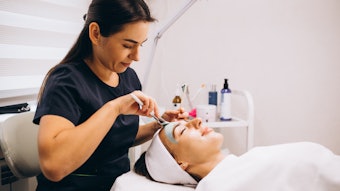
A Positive Customer Experience Builds Loyalty
“People will forget what you said, people will forget what you did, but people will never forget how you made them feel.” – Maya Angelou
When it comes to delivering a five-star patient experience, this quote sums it up perfectly. We all want five-star reviews and a five-star reputation, but is your practice providing a five-star customer experience?
The customer experiences that patients remember are the ones that were either amazing or terrible. According to Salesforce research, 89% of consumers are more likely to make another purchase (or in this case, book another service/procedure or purchase retail products) after a positive customer service experience. A positive customer experience builds loyalty, and loyal patients are a great referral source. In fact, according to Forbes, a loyal patient is 4x more likely to refer a friend.
So, how do you ensure your team is properly trained and well versed in providing a five-star patient experience? There are seven key steps and none of them are optional. You can’t just do 4-5 of them; you must master them all.
The 7 Steps of the Patient Experience
Each of these steps represents a distinct opportunity to provide high quality patient care and ensure a positive, memorable customer service experience.
1. Website. Your website is your virtual brochure. You cannot afford to skimp on creating an informative, aesthetically pleasing website that is SEO optimized and reflects your brand and image. This is the very first impression potential clients will see after googling a particular treatment or procedure. If it looks unprofessional, outdated, slow, hard to navigate or does not have enough clear, concise content, clients will bounce and go to the next website link in their search results. Your website must establish your brand and appeal to your ideal client and demographic. I highly recommend you use a website development company specializing in the aesthetics space. Make sure you have a professional gallery of before/after photos, as this is the most visited page. If you are brand new, work with your vendors to get access to photos.
If you get a lead from your website, your team should respond right away. Ideally within the first hour, someone on your staff should:
- Call the client
- Immediately send out an email
- Enter the contact info into patient software
- Follow up with an SMS via the patient software if you have that capability
Within 48 hours, call again, send another email and another SMS. Within one week, call one more time, send a final email and a final SMS message.
2. Phone. I cannot emphasize enough the importance of training your front desk team. It is a critical step of the patient experience. The person answering the phone will be the first direct experience and human contact a patient has with your practice and can make the difference as to whether you gain or lose a patient. A patient’s initial experience will be determined within seconds. First impressions are the backbone of your practice and your brand. You want these staff members to have dynamic personalities and be highly trained.
Your front desk member must be able to credential your providers as well as the practice and be able to communicate your Unique Value Proposition (UVP). They must also be well educated on the services/procedures you provide as well as the categories of services. In addition, they should be converting 70% of calls into consultations. If they are not, you are leaving significant revenue on the table.
Your front desk team should utilize these best practices when it comes to phone skills:
- Picking up the phone by the 3rd ring
- Greeting the caller cheerfully with their name, title, and name of the practice
- Getting the caller’s name and call back number and referring to their name often during the call
- Asking the caller how they found your practice (referral source)
- Before placing a caller on hold, always asking if you may do so and waiting for the answer
- Thanking the caller every 20-30 seconds they are on hold until you resume the call
- Recommending scheduling a consultation or appointment
- Providing two different appointment dates to improve acceptance rate
- Before hanging up, always asking if you’ve responded to all the caller’s questions
- Informing the caller that you are happy to follow up with additional information
- Asking the caller to provide additional contact info so you can send more info (email or mailing address)
3. Entering the practice. You want a patient’s first impression entering your practice to be welcoming and positive. Make sure your front desk team greets each patient by name. Encourage them to stand up and shake the patient’s hand as they introduce themselves. These personal touches go a long way. If you have a returning patient on the schedule, make it clear you remember them. Even if you have had a stressful day, keep your attitude positive, focus on them and do not complain. Treat every patient as your most important patient.
Make sure your front office team follows a dress code (keep it simple and classic) that is aligned with your brand. Are you the Ritz Carlton, Marriot or a Holiday Inn? Which image do you want to convey to your clients?
Make sure your waiting area is spotless and your office furniture and space reflects your brand. Ensure you have current reading material and educational information available on the various services and retail products you offer. Having a beverage station with coffee and water bottles can help create an inviting atmosphere.
Honor your patients time by encouraging your entire team to stick to a schedule and promote operational efficiency. If your provider is running behind, let the patient know and update them frequently.
4. Consultation. The consultation is really where the rubber meets the road. This is where the magic happens. As part of our comprehensive sales training course, APX Platform has an in-depth module on consultations that convert, but here are just a few elements of a successful consultation.
- Schedule enough time so that the patient feels heard, understood and not rushed.
- Your providers must take an engaged approach
and use the LAER Model (Listen, Acknowledge, Engage, Respond) - Don’t talk, listen. Don’t tell, ask probing questions. Don’t sell, solve a problem. Don’t pitch, inform.
Don’t leave without providing a solution. - Explain features/benefits of each treatment.
- Connect with patients so you can establish trust, understand their needs/desires.
Asking the right questions will help uncover more about them, which gives you the ability to offer the appropriate solution based on their responses.
5. Treatment Plan. Building and presenting treatment plans helps increase patient retention, increases the lifetime value of a patient, and produces the best possible results and outcomes. Presenting a comprehensive treatment plan gains the patient’s trust. Make sure to ask them if you have answered all their questions. Offer solutions including combination therapies and skin care regimens if appropriate. Get their buy in by asking if they are comfortable with the plan and gain a commitment.
6. The Close. As you are closing a consultation, you will want to address and handle any objections. The most effective way to handle objections is to have pre-emptively explained the features, benefits, value and the feeling associated with the outcome. Clearly explaining the surgery or treatment and setting proper expectations, credentialing yourself and practice as
to why they should choose you and asking open-
ended questions all help to educate the patient and sell the solution.
7. Follow Up. I love the saying, “The fortune is in the follow up,” because it is so true. Did you know that 45% of patient inquiries are not followed up on at all? Mastering the follow up can set your practice apart from the competition. Here are a few suggestions:
- Send a hand-written thank you note to new patients after they visit your practice. This is such a nice, personal touch in a digital world.
- Schedule a follow-up phone call 1-2 days post procedure or treatment to check in with the patient.
- Schedule a follow up call 7 days out if the patient did not schedule a service after a consultation. Track and measure your conversion rates.
- Stay in touch with your patients via regular monthly newsletters that spotlight upcoming events, new staff, loyalty programs, testimonials, specials, new treatment options, etc.
- Send hand-written thank you notes for referrals and perhaps offer the referring patient an extra add on for their next visit.
Again, this is just a broad-stroke overview of the patient experience. More deep-dive training can be accessed within APX Platform. I’ll leave you with a quick list of tips for providing world class service to your patients you can download here. As always, my team and I are always here to help. You can join our Aesthetics Insights Facebook Group, or you can always email your questions to [email protected].
Terri Ross is a world-renowned, practice management expert, thought leader, and international speaker in the medical aesthetic industry. After 10 years of running a highly successful practice management firm, Terri disrupted the aesthetic industry by introducing APX Platform, a cutting-edge, business intelligence and on-demand growth and training solution to increase efficiency and profitability. Terri is an official partner and trainer with the American Medical Spa Association (AMSPA), and lectures all over the world for top aesthetic societies. She is a regular contributor to major aesthetic publications and hosts her own informative podcast, “In Touch with Terri: Trade Secrets for Medical Aesthetics.”











